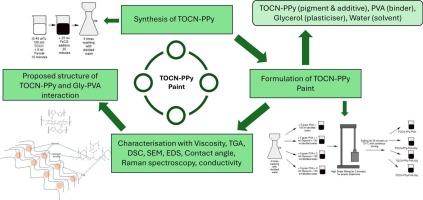由聚吡咯和TOCN衍生的生物基涂料的合成、配方和表征
IF 7.3
2区 材料科学
Q1 CHEMISTRY, APPLIED
引用次数: 0
摘要
本研究将tempo氧化纤维素纳米纤维(TOCN)与聚吡啶(PPy)结合,并将聚乙烯醇(PVA)作为粘合剂,甘油作为增塑剂,开发了一种生物基涂料。通过原位聚合合成了TOCN-PPy复合材料,然后进行了洗涤工艺以确保成分的纯度。高剪切混合和控制热处理产生均匀和稳定的配方。扫描电镜(SEM)显示了一个分散良好的纳米纤维网络,甘油含量的增加有助于光滑的表面形貌。这可能与处理过程中观察到的灵活性的提高有关。拉曼分析进一步证实了聚吡咯的存在,并揭示了PVA和甘油影响下聚合物分散和氢键增强的光谱位移。接触角测量结果表明,甘油含量的增加增加了润湿性,降低了疏水性,增强了涂层的适应性。热重分析(TGA)显示了多阶段降解,聚吡咯提高了热稳定性。在含有甘油的样品中观察到的增强的柔韧性归因于其塑化作用,这一点可以通过形态学和处理观察得到证明。DSC还用于玻璃化转变,熔化和热分解行为以及热稳定性趋势。这些发现强调了TOCN-PPy涂层的可调性,平衡了结构完整性、热性能和各种工业应用的润湿性。研究结果还强调了TOCN-PPy复合材料作为高性能、环保涂料的潜力,支持绿色化学和循环生物经济的创新。本文章由计算机程序翻译,如有差异,请以英文原文为准。

Synthesis, formulation, and characterization of a bio-based paint derived from TOCN and polypyrrole
This study presents the development of a biobased paint by integrating TEMPO-oxidized cellulose nanofibers (TOCN) with polypyrrole (PPy) and incorporating polyvinyl alcohol (PVA) as a binder and glycerol as a plasticizer. The TOCN-PPy composite was synthesized via in-situ polymerization, followed by a washing process to ensure compositional purity. High-shear mixing and controlled thermal treatment produced homogeneous and stable formulations. Scanning Electron Microscopy (SEM) revealed a well-dispersed nanofiber network, with increased glycerol content contributing to smoother surface morphology. This may correlate with improved flexibility observed during handling. Raman analysis further confirmed the presence of polypyrrole and revealed spectral shifts associated with enhanced polymer dispersion and hydrogen bonding influenced by PVA and glycerol. Contact angle measurements showed that higher glycerol content increased wettability, reducing hydrophobicity and enhancing adaptability for coating applications. Thermogravimetric Analysis (TGA) revealed multi-stage degradation, with polypyrrole improving thermal stability. The enhanced flexibility observed in glycerol-containing samples is attributed to its plasticizing effect, as evidenced by morphological and handling observations. DSC was also employed for glass transition, melting and thermal decomposition behavior, and thermal stability trends. These findings emphasize the tunability of TOCN-PPy coatings, balancing structural integrity, thermal performance, and wettability for various industrial applications. The results also highlight the potential of TOCN-PPy composites as high-performance, eco-friendly coatings, supporting innovations in green chemistry and the circular bioeconomy.
求助全文
通过发布文献求助,成功后即可免费获取论文全文。
去求助
来源期刊

Progress in Organic Coatings
工程技术-材料科学:膜
CiteScore
11.40
自引率
15.20%
发文量
577
审稿时长
48 days
期刊介绍:
The aim of this international journal is to analyse and publicise the progress and current state of knowledge in the field of organic coatings and related materials. The Editors and the Editorial Board members will solicit both review and research papers from academic and industrial scientists who are actively engaged in research and development or, in the case of review papers, have extensive experience in the subject to be reviewed. Unsolicited manuscripts will be accepted if they meet the journal''s requirements. The journal publishes papers dealing with such subjects as:
• Chemical, physical and technological properties of organic coatings and related materials
• Problems and methods of preparation, manufacture and application of these materials
• Performance, testing and analysis.
 求助内容:
求助内容: 应助结果提醒方式:
应助结果提醒方式:


